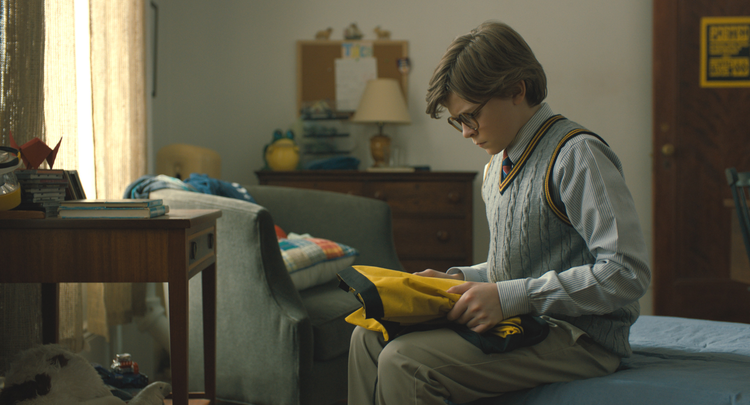
(Image: americamagazine.com)
THE GOLDFINCH — 2 STARS
Normally, the book vs. movie argument centers around missed opportunities. The majority lament becomes about the necessary condensing and trimming executed by writers and filmmakers that shaves too much of the nuanced essence from the sprawling story of the written page. With The Goldfinch, a different effect occurs. Given a longer running time than most movies already and all the patience in the world, any additions of extra depth and detail to the film adaptation would not help. What is already present is bloated, sluggish, and ineffectual. That’s an odd circumstance to say the least. Talk about a movie that should have stayed a book.
The infeasible task of adapting Donna Tartt’s Pulitzer Prize-winning novel fell on Academy Award-nominated Tinker Tailor Soldier Spy screenwriter Peter Straughton (who, just to note, followed his Oscar glow with the trio Frank, Our Brand is Crisis, and The Snowman) and Brooklyn director John Crowley. The title refers to the Rembrandt pupil Carl Fabritius’s treasured 1654 still life painting that hangs today at the Mauritshuis in The Hague. The painting’s existence is significant as one of the few works of the artist to survive an explosion and fire that killed the artist himself in the same year.
Playing with ironic fate, that very painting resides prominently in the fictional setting of another explosion, this one of the terrorist variety occuring this century at New York’s Metropolitan Museum of Art. Theo Decker, played by Pete’s Dragon and Wonderstruck child star Oakes Fegley, survives a bombing that killed his beloved mother Audrey (Hailey Wist) while observing Fabritius’s oil-painted panel. The rush of sensory and mental memories of this tragedy manifest throughout the film in flashback snippets of nightmares shared by the teenager and the adult Theo we observe, played by Baby Driver’s Ansel Elgort.
LESSON #1: YOU NEVER KNOW WHAT’S GOING TO DECIDE YOUR FUTURE — Sure, everything ahead of people is unknown, but foresight wouldn’t hurt. Wearing shellshock like a sealing shellac at both ages, Theo is a young man growing in and out of several personal attachments of formative significance. At the time of his mother’s death, he is undefined and without true parents and solid friends. His future clean-cut and reinvented self, clad in tailored suits and posh spectacles, may look like an improvement on the outside, but is worse than the kid he was on the inside.
No matter the lift provided with each relationship, Theo remains consumed by the resonating aftermath of his mother’s death and the presumed destruction and loss of Fabritius’s masterpiece. In just a shade under two-and-a-half hours, The Goldfinch, like the novel, hops back and forth between the past and the present to saunter alongside the guiding tangents in Theo’s life. The transitions are abrupt and terribly uneven, matching the rough gamut of these intersecting people.
With his deadbeat father Larry (Luke Wilson) absent, Theo is taken in by the wealthy Barbour family and their well-to-do matriarch Samantha (Oscar winner Nicole Kidman) and her collection of welcoming or indifferent silver spoon children and schoolmates. A clue from the bombing bonds the inquisitive Theo to a fellow young victim, knotted by their fates, named Pippa (Aimee Laurence) and leads him to her legal guardian James “Hobie” Hobart, a restorer of high-end antiques. Theo would learn the trade and go on to work for Hobie as his slick and cultured front-man salesman.
Theo’s growing comfort and recovery is derailed when Larry resurfaces to claim his son and the financial benefits that come with him. Larry and his prostitute girlfriend Xandra (Sarah Paulson) remove Theo from the bustling and colorful urban penthouse and whisk him west to Las Vegas to a virtually empty housing bubble townhouse subdivision in the flatly beige desert. There, Theo is able to make one awkward friend, a woeful and troublemaking Ukranian immigrant named Boris, played by Stranger Things lead and Timothee Chalamet wannabe Finn Wolfhard.
LESSON #2: DO BETTER THAN MEDICATE YOUR PROBLEMS — From the moment Samatha Barbour volunteers some old prescription meds to Theo, we watch a parade of people offering easy exits and a young man that will never shake those vices. Every hit of a recreational drug, swig of a bottle, or drag of a cigarette adds to tailspin instead of relief. Those choices don’t help a man forget.
Broad character strokes are used to paint every character listed above not named Theo Decker. While this cannot compare to the sympathetic levels as his heart-warming turns in Pete’s Dragon and Wonderstruck, Oakes Fegley impresses mightily with his third performance of youthful loss and self-discovery. The young performer never overacts a single scene. He clearly taken cues and had good practice with this tonal level and it shows. Ansel Elgort is a good match of maturation to Fegley. He too can convey and engage subtle character fractures and always garner your eye contact as a viewer.
Everyone else around them are a revolving door of eccentricity. They are static sculptures of veiled enigma. The likes of Kidman and Wright represent stature and the promising roots of educating morals for the troubled Theo, only to never shift with the highs and lows of the kid. The contrasting flighty factors like Wilson, Paulson, and Wolfhard fare no better. Their presences feel fleeting and little more than soapy opera sludge when they are supposed to matter. It’s astonishing how something so full of eclectic talent could be so empty in impact.
LESSON #3: THE INABILITY TO SHAKE A SENSE OF FAULT — No matter which type of person above Theo confides his trust in, the hindrance to greater connection is thwarted by a burden of his own creation. He blames himself for being the reason he and his mother were even in the museum that fateful day. During this journey, Theo finds some shared tragedy and people to lean on or collapse with, but he is his own worst symptom for healing.
The soft gloss from cinematographer Roger Deakins counts as a feather in this movie’s hat. The camera legend mixes foreground and background points of focus to shroud suspicion and mystery in a striking way. However, it is an effect that given up on after the first 30 minutes. More of that sense of space, atmosphere, and tone could have gone far deeper into such a lengthy and weighty picture. The very same can be said for the very slight and weak score from composer Trevor Gureckis. Many moments could have used some cued oomph to press more importance. What is there is pretty and all, with its privileged (albeit esoteric) ocean of antiquity, but to what end becomes the question.
As aforementioned with the transitions, the meandering pacing of The Goldfinch is nearly maddening. There was more than enough time here and committed work from Fegley and Elgort to cure even the heaviest cement into sturdy drama. Instead, nearly every angle building towards a promised denouement of consequence, especially the titular piece of art, fades horribly to indifference. This story, in movie form, fails to make one care. Anything that lingers feels extraneous at best.

LOGO DESIGNED BY MEENTS ILLUSTRATED (#823)
from REVIEW BLOG - Every Movie Has a Lesson https://ift.tt/2Lyh13y







No comments:
Post a Comment